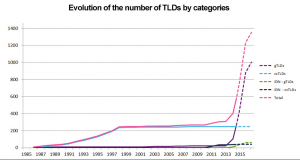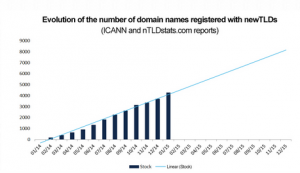
By the end of 2014, 470 new generic domains (new gTLDs) have been delegated to the root zone. Those included 39 domains using non-Latin characters and 290 country code domains (ccTLDs) of which 41 used non-Latin characters.
At the end of the year 2014, there were over 760 TLDs in the root in all, which constitutes an increase of 89% compared with the year 2013. In comparison with 2012, it is an increase of 147% which mainly is the result of the release of the new TLDs.
Things have changed
What these figures demonstrate is that the domain name system has gone through dynamic changes in a few months, more than during the first twenty years since its introduction. While most new TLDs that exist today were launched in 2014, the phenomenon is ongoing. ICANN is still processing new domain files and it seems that this development will continue in 2015 and 2016. It is projected that the number of new TLDs entering the Internet will reach around 1,350 by the end of 2016.
At the same time it is no secret that the fast growing number of extensions does not correspond to equally high interest in the nTLDs from both domain businesses and Internet users. According to the ICANN’s October report, 72 % of domains released before that month had less than 5 thousand registered names, and only less than 1 % of new extensions had more than 100 thousand registrations, which in some cases was the result of aggressive marketing strategies.
An example of such strategies may be the campaign organised by the operator of .xyz domain who handed out new names under their managed extension to unaware subscribers. As a result, at the end of last year .xyz registry had over 760 thousand domain names, which accounted for 21 % of all their registrations on 31 December.
It remains to be seen at the end of the first year of the domain life cycle whether the logic behind amassing high volumes to ensure sufficient recognition on the domain market will hold true. There may be other vital factors that a success of a domain depends on.
Domain’s value generating potential
Giving away domain names may be perceived by some as depreciating the value of the domain. Those who decide to pay substantial sums for a single domain at auctions must be certain of its value-creating and investment potential. The winning companies competing at auctions for the management of a TLD bear costs of millions of dollars. Last year ICANN’s auctioning of 10 extensions generated over $35 million. Private auctions generated even greater amounts.
True success of a TLD can be observed over time, not just through the prism of large volumes of sales despite this strategy’s popularity. The utilisation rate is just as important as is the uphold of the domain’s dynamic, according to the report. Temporary promotions are not the guarantee of the high turnover rate at the end of the first year.
What’s to come?
The outlook on nTLD market growth in 2015 looks rather optimistic with the estimate of over 8 million new domain names registered by the end of the year. It is projected that the number of currently registered nTLDs of nearly 4.5 million will double by the end of 2015. That does not mean the drastic change in the dynamic or interest in the new TLDs in general.
The above trajectory is considerably clear. Currently, nTLDs constitute 1.3% of the market share. While the number of new extensions released to the Internet is growing, the resistance of legacy TLD .com and ccTLDs is quite strong.
A wide range of marketing models and approaches adopted by nTLDs does not allow to classify the new domains as a homogenous whole. The coming months will show which techniques have proved most successful in establishing a lasting presence.




